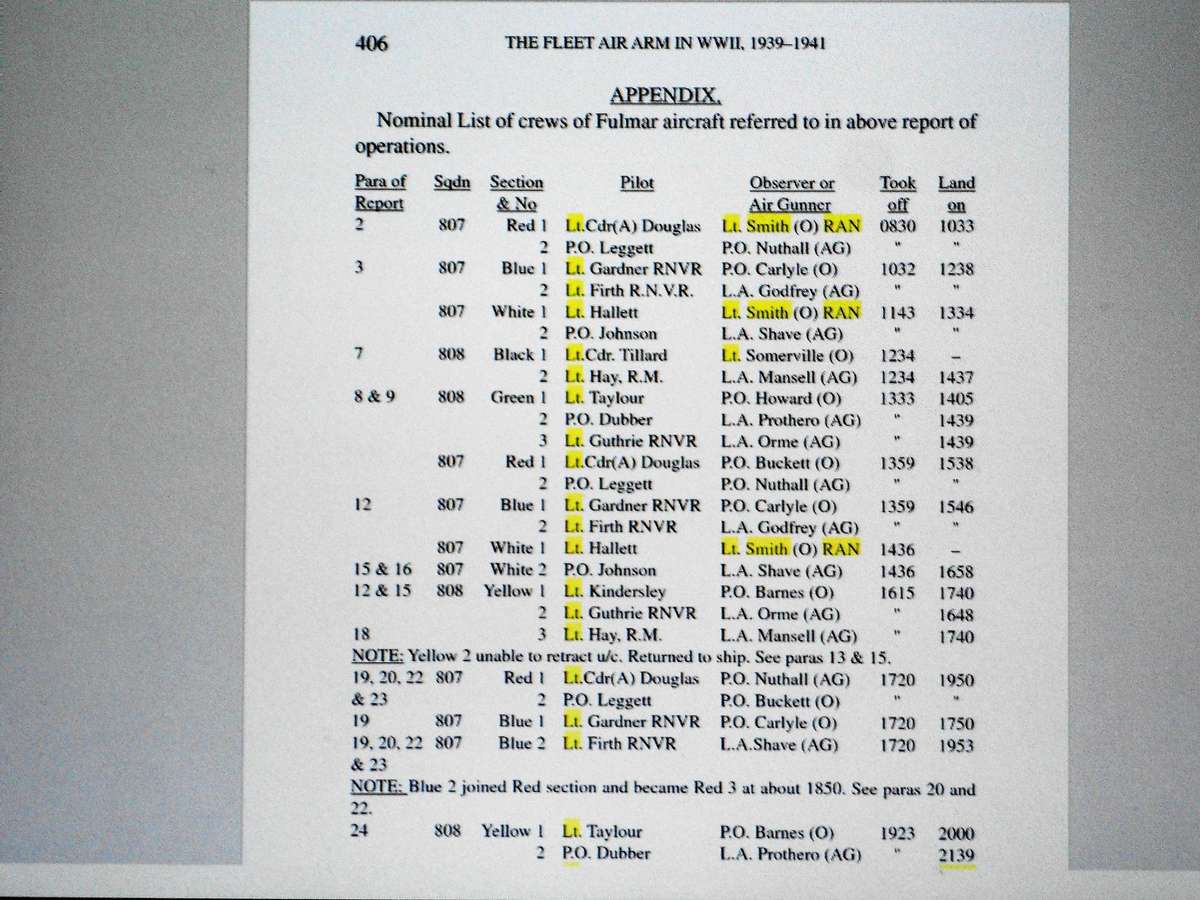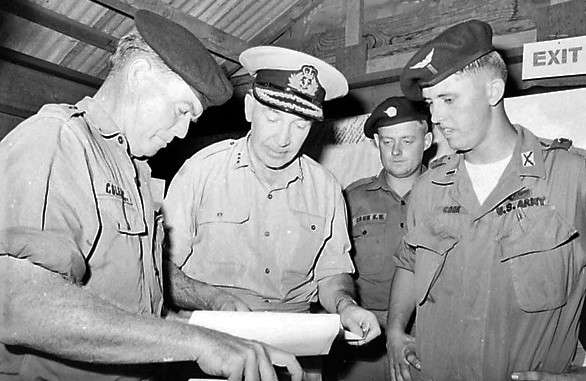
As we enter the 70th Anniversary year of the RAN Fleet Air Arm it is appropriate to remember one of its founding members. Kim Dunstan takes a look at the remarkable life and times of Admiral Sir Victor Smith, AC, KBE, CB, DSC, RAN.
Preface
Generally acknowledged as the father of the Royal Australian Fleet Air Arm (FAA), Sir Victor Smith was an outstanding leader, greatly respected, and a man of rare ability and distinction. He spent just short of 49-years in the navy – from 1927 as a cadet midshipman until retiring with the rank of Admiral in 1975. His distinguished WW2 record – much of it with the RN Fleet Air Arm – led to his involvement in the early planning of the RAN FAA. A link that continued as Executive Officer of HMAS Sydney (111); Chief Staff Officer at HMAS Nirimba; Captain of HMAS Albatross at Nowra, and then HMAS Melbourne (11). In November 1970 he was appointed Chairman, Chiefs of Staff Committee, Australia’s most senior military officer. The following provides an outline of Sir Victor’s remarkable career, and his vital contribution towards the formation of the RAN Fleet Air Arm.
Early Life
Victor Smith was born on 9 May 1913 at Chatswood, NSW, to George and Una Smith (nee Trumper). He was the second of three children and christened Victor Alfred Trumper. Victor and Alfred were his parent’s brothers – uncle Victor Trumper being the famous cricketer. Smith was educated at Chatswood public primary school, then at Chatswood High for a year during which he passed the entry exams for the Royal Australian Naval College at Jervis Bay.
Smith was a keen student and enjoyed sports such as rugby, tennis, and swimming. He also had an intertest in music and was active in the local Chatswood Wolf Cub Pack, where an RAN Lieutenant Commander attended – teaching the boys how to do bends and hitches and telling stories about naval life. This was the starting point for Smith’s interest in the navy, an interest that grew as he sought more information, further influenced by a teacher with a son at Jervis Bay who spoke to him about the Navy.
Cadet Midshipman Smith
After applying to join the Royal Australian Naval College (RANC) Smith underwent a medical examination and then faced an interview panel for further tests and questions. In 1926 there were more than 200 candidates for the 13 college vacancies for the following year. A letter was soon received stating he was selected as a cadet midshipman and should be ready to take-up the appointment at the RANC at Jervis Bay early in February 1927. At Central Railway Station, Sydney, a group of 13-year-old boys were put on a train for Bomaderry, on the NSW South Coast. A Chief Petty Officer then accompanied them on the 25-mile road trip to the RANC.
Life at the college was not easy, but there was a sound educational programme with a good balance between academic and naval subjects, and plenty of sports. One of the diversions the cadets had was a weekly dance on Wednesday nights where longsuffering officers and masters’ wives would act as partners. It was here that Smith’s interest in music was directed into playing the piano for the dance. Another musical task was playing the organ for the hymns at divisions and Sunday chapel.
In 1930 his class was drafted to HMAS Cerberus, Flinders Naval Depot, near Melbourne for further training, graduating at the end of 1930. After graduation, there were several weeks leave then, on 20 January 1931, he was posted to HMAS Canberra as a cadet midshipman. After several months, he was promoted to midshipman which meant new responsibilities and more practical experience in the torpedo, gunnery, navigation, and engineering departments – also being midshipman of the motor boat for liberty men and officers going ashore. Canberra was Flagship doing cruises to Tasmania in February and in Winter to the north, sometimes to New Zealand, Suva or around Australia; all valuable experience for the young cadet officer.
Sub Lieutenant Smith
By May 1932 there were five midshipmen left of the original group and all went on the Orient Line RMS Otranto to the Mediterranean to join HMS London, the Flagship of the First Cruiser Squadron, at Malta. Smith found London to be a very smart ship but did not find life as a midshipman on London to be much different to that on Canberra, as the rivalry between the two County Class cruisers Canberra and Australia was very intense.
An exciting time occurred when the midshipmen were sent on a two-week course to HMS Glorious, the aircraft carrier in the Med Fleet. Smith found the air course to be engaging and full of interest. The advantages of an aircraft carrier to the fleet were immediately apparent and the duties of the Fleet Air Arm officers fired his enthusiasm with the realisation that aircraft were to play an increasingly important role in the navy. The experience on Glorious was a major influence in his decision to specialise in naval aviation.
After returning to HMS London the midshipmen spent several months on destroyers, then back to London where, in August 1933, after passing seamanship examinations, Smith was promoted to acting sub lieutenant. The next move was to England to commence a six-month sub lieutenants’ course at the Royal Naval College, Greenwich, including a series of courses at Portsmouth. On completion in 1935 he returned to Australia and joined HMAS Canberra as a sub lieutenant.
The Move to Naval Aviation
In early 1936 Sub Lieutenant Smith transferred to HMAS Australia serving in the Mediterranean (at the time of the Italian invasion of Ethiopia) and in March of that year he was promoted to lieutenant. Australia returned home later in 1936 and resumed duties on the Australia station. After deciding to specialise in aviation Lt Smith’s flying career began in March 1937 when he started training as a Naval Observer in the UK at RAF Lee-on-Solent.
A pilots course was not open to RAN officers at the time, as from the end of WW1 until 1947 the Royal Australian Air Force supplied the aircraft, pilots and maintainers for the Seagull/Walrus amphibians on RAN ships – an unsatisfactory situation that in later years led to the formation of the RAN Fleet Air Arm. So, in the 1930s, if you wanted to specialise in naval aviation you became an Observer.
The Observers course was about seven months and on completion Smith joined HMS Victory for a few weeks before being appointed to HMS Glorious finishing a refit at Portsmouth, then proceeding to the Mediterranean at the beginning of 1938. Here he discovered that Observers remained as ships company and continued with other naval duties whereas pilots held both naval and air force commissions – yet another compromise reached after WW1. Although attached to 825 Squadron, flying in Fairey Swordfish torpedo bombers, he was also an assistant divisional officer and became ships sports officer.
World War 2
In Italy Mussolini was building its military forces and it was known that Germany had used the Spanish Civil War to test its war weapons. As Hitler was rampaging in the early part of 1939 there was a feeling of disquiet in Britain that war was likely to happen. At the end of August 1939 Smith left HMS Glorious to attend a meteorological course in England, to be followed by his return to Australia. Because war was declared on 3 September 1939 the Met course was cancelled and he was sent north to Scapa Flow to join 821 Squadron on HMS Ark Royal. It was off to war – and no return to Australia.
Left: an extract from the book ‘Fleet Air Arm in the Second World War,’ Edited by Ben Jones M.Phil. PhD., printed by Ashgate Publishing 2012 & Rutledge 2016, mentions Lt Smith (O) RAN several times. This coincides with VAT Smith’s time flying with 807 Squadron (Fulmars) on HMS Ark Royal in May 1941. You will notice the 1436 White 1 flight didn’t return to the ship – the Alexandria convoy report for 8 May 1941 from Ark Royal [TNA, ADM 199/656] indicates that at about 1510 enemy aircraft attacked the fleet and White 1 force landed in the sea with the crew picked up by the destroyer HMS Foresight. VAT Smith was shot down twice and this appears to be the first occasion. (Click on image to enlarge).
Prior to the outbreak of war there had been extensive administrative changes to the RN Fleet Air Arm with authority transferred to the Admiralty. A good thing but the RN was stuck with aircraft of limited capacity such as the Fairey Swordfish, unsuitable fighters, and a shortage of pilots.
HMS Ark Royal was dispatched to the South Atlantic and her aircraft were used in wide area searches for the German pocket battle ship Graf Spee without success. But the RN cruisers managed to damage Graf Spee, chasing it into the River Plate at Montevideo which led to its end. In 1940 Ark Royal returned to Scapa Flow where 821 Swordfish Squadron was transferred to the RN Air Station at Hatston in the Orkneys, here the main task was anti-submarine patrols to force U-boats further north.
When the German battlecruiser Scharnhorst and its large escort were discovered sailing south along the coast of Norway, 821 Squadron’s Swordfish aircraft were ordered to attack. On 21 June 1940, under the command of Lt Smith, six Fairey Swordfish, with long range tanks fitted, flew across the North Sea and located the German force. In the face of fierce anti-aircraft fire a torpedo attack was carried out by the Swordfish but no hits were scored and two aircraft were lost. Short of fuel the aircraft flew to the Shetlands to refuel before returning to RNAS Hatston. Later the senior pilot and Smith received Mention in Despatches.
Atlantic & Mediterranean Action
In August 1940 Lt Smith was transferred to RNAS Eastleigh, HMS Raven, attached to 760 Squadron, then in September he joined 807 Squadron equipped with Fairey Fulmar 1s and embarked on HMS Pegasus, with the task of protecting Atlantic convoys from attacks by German Fokker-Wolf Condor aircraft. In February 1941 the squadron transferred to HMS Furious sailing to Lagos where the aircraft disembarked to search for German raiders. No raiders were found, but Smith contracted malaria which plagued him for years.
In April 1941 re-equipped with Fulmar 2s, 807 Squadron joined HMS Ark Royal defending the Malta convoys. In May and again in September Smith was shot down and on both occasions (with the pilot) was rescued by a destroyer. In November 1941 when Ark Royal was torpedoed off Gibraltar, he again boarded a destroyer. At the end of 1941 Smith was awarded a DSC “for outstanding zeal, patience, cheerfulness and setting an example of wholeheartedness devotion to duty”.
The Pacific War & Promotion
Back in England Lt Smith received instructions to return to Australia. During the voyage home on 7 December 1941 Japan entered the war. He arrived in Sydney in February 1942 after serving five years overseas. Returning from leave he went to HMAS Australia for liaison duties with the American cruiser USS Chicago gaining knowledge of USN methods. Then in May 1942 Smith joined HMAS Canberra as a replacement observer for the ship’s Seagull aircraft. When Canberra was part of the force protecting the U.S. Marines landing at Guadalcanal, the ship became a casualty of the Battle of Savo Island, sinking on 9 August 1942. But Smith was rescued with many of the crew and returned to Sydney.
His next appointment, on 14 September 1942, was to HMAS Assault, a combined operations amphibious landing training centre, on Nelsons Bay at Port Stephens, NSW. This posting ended in early December when appointed to take charge of a draft to collect HMAS Shropshire in England which the Admiralty provided as a replacement after the loss of HMAS Canberra. He was to be an Observer for the ship’s aircraft, but the catapult had been removed and was without an aircraft. In March 1943 Smith was made acting lieutenant commander and requested a transfer to the RN FAA. This was approved and on July 1943 he joined the American-built escort aircraft carrier HMS Tracker as Operations Officer. Tracker did convoy duty in the Atlantic then in February 1944 she sailed from Scapa Flow in convoy for Murmansk. The weather was atrocious and flying limited, but her aircraft assisted in sinking two U-boats and destroying German long-range aircraft.
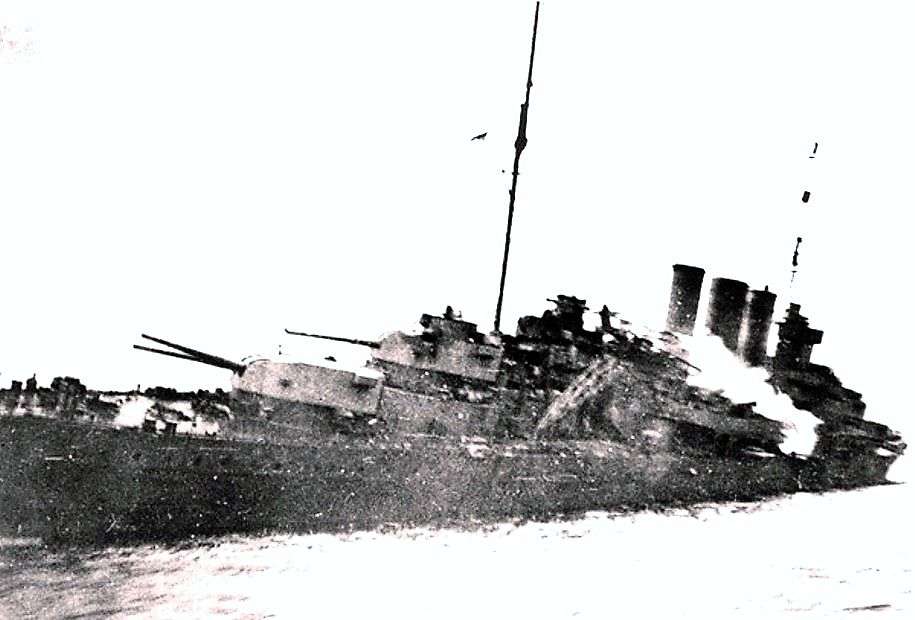
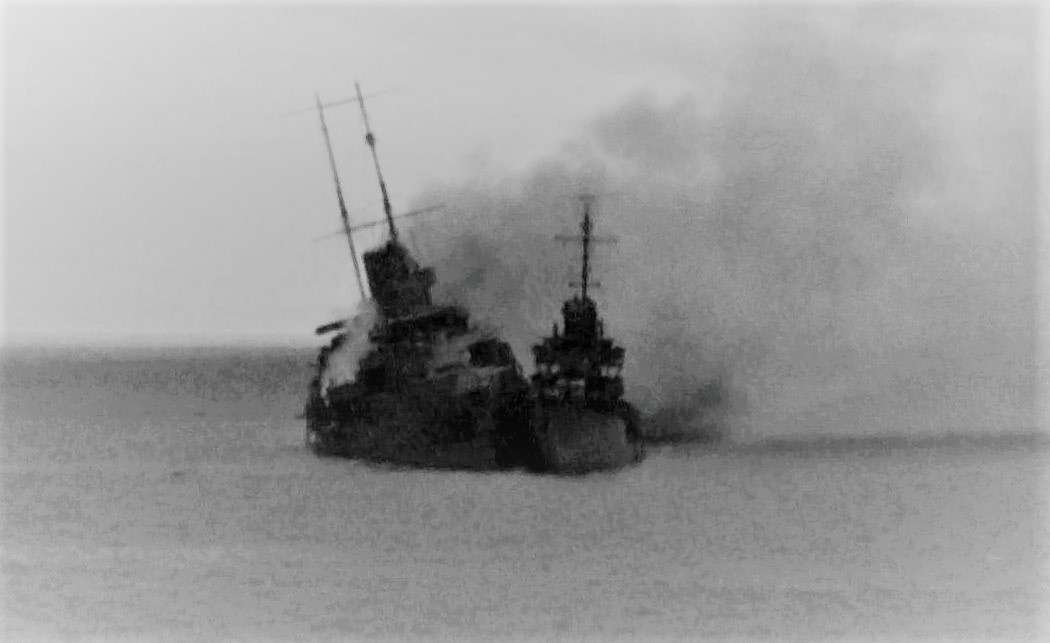 Two images of the mortally wounded HMAS Canberra at Savo Island. The second shows the USS Patterson closing alongside to rescue Canberra’s survivors. Smith was aboard during this action.
Two images of the mortally wounded HMAS Canberra at Savo Island. The second shows the USS Patterson closing alongside to rescue Canberra’s survivors. Smith was aboard during this action.
The Invasion of Normandy
Lt Cdr Smith’s next appointment was for air planning duties on the staff of Flag Officer British Assault Area for ‘Operation Neptune,’ part of ‘Operation Overlord,’ for the invasion of Normandy. He joined FOBAA’s staff in April 1944 engaged in ‘Operation Neptune’ planning and liaising with other forces that were cooperating with the Royal Navy. In the early hours of 6 June 1944, along with many other ships, the staff arrived at the coast of Normandy and after several days they moved ashore where Smith continued working with senior Army and RAF officers. The main naval requirement was for the protection of shipping in the Channel and near the beaches.
In September 1944 Lt Cdr Smith was recalled to England to work with the Admiralty to plan the shore facilities for the RN Fleet Air Arm branch of the British Pacific Fleet (BPF), which was due to arrive in Australia in November 1944. This was valuable experience as Smith soon transferred to Vice Admiral (Q’s) staff in Melbourne for air planning duties; (Q) was an Army term adopted to cover naval logistics in all its aspects.
Marriage & Australia
The time in England before and after the Normandy landings gave Smith the opportunity to meet, court and marry Miss Nanette Susan Harrison. For that reason, he was always thankful the Normandy appointment came his way. The couple were engaged in September 1944 and when he was told on 23 October he would be leaving for Australia in 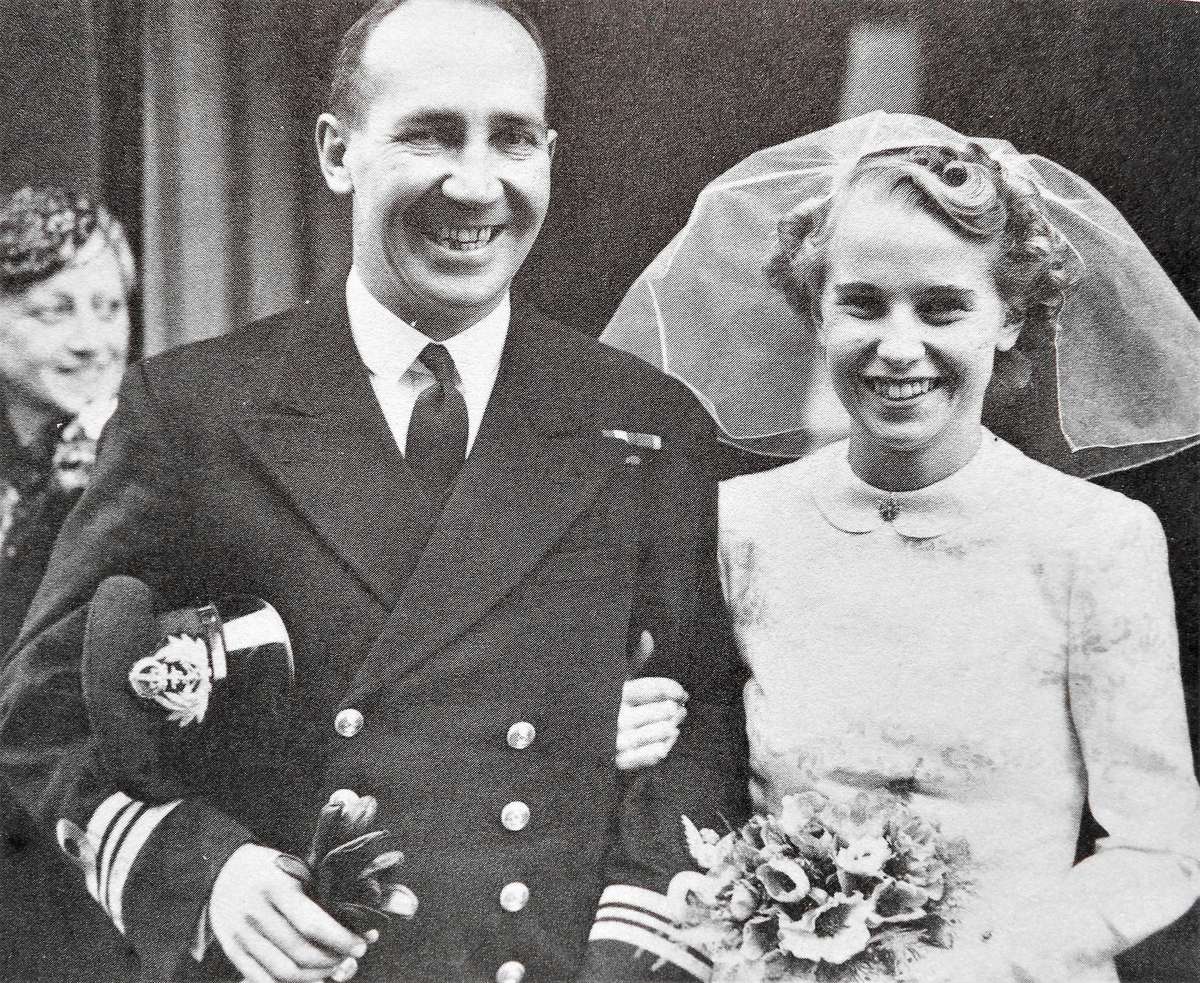 10 days, he phoned Nanette and asked if they could be married the following Saturday. With five days’ notice they were married, then following a brief honeymoon he left for Australia. They did not meet again until late 1945, when he returned to England to gather details for the RAN Fleet Air Arm plan.
10 days, he phoned Nanette and asked if they could be married the following Saturday. With five days’ notice they were married, then following a brief honeymoon he left for Australia. They did not meet again until late 1945, when he returned to England to gather details for the RAN Fleet Air Arm plan.
British Pacific Fleet FAA
In November 1944 three RN Fleet Air Arm planning officers and Smith, assigned to the staff of the Flag Officer Air Pacific, travelled via the Atlantic and USA to join Vice Admiral (Q’s) headquarters at Albert Park near Melbourne. By arrangement with the RAAF the airfields at Nowra, Schofields and Jervis Bay were made available to the RN as Mobile Naval Air Bases. Nowra became HMS Nabbington with Jervis Bay as a satellite and Schofields became HMS Nabthorpe. The help from Navy Office and the Department of Works was of great assistance.
Left: VAT at his wedding to Nanette Smith (nee Harrison), his lifelong partner.
The RAN Fleet Air Arm
When VJ Day approached the RAN Director of Plans, Commander George Gatacre, spoke to Smith about post-war plans for the RAN which included two aircraft carriers, two air groups, plus shore establishments and facilities – directing him to produce a draft plan. This could only be a first draft as most details were not available, and well beyond the ability of one planner. The draft plan was passed to Navy Office – then after leaving the staff of VA(Q) – on 20 October 1945 Smith departed for the UK to work on details for the establishment of the RAN Fleet Air Arm. The return to London also meant a reunion with Nanette after being apart for twelve months.
Attached to Australia House in London, Smith began filling the gaps in the draft RAN FAA plan, working with the Admiralty who provided a desk in the Directorate of Air Organisation and Training. For a year, he gathered information, speaking to the experts, and providing regular reports to Navy Office in Australia. The next step was the staffing and formation of an RAN FAA Air Planning office. In early 1947 three senior RN officers and later a civilian stores officer were appointed to the planning staff in Australia, together with Smith. The objective being to produce a comprehensive plan for submission to the Australian Cabinet. The plan put all Fleet Air Arm functions in the hands of the RAN to which the Navy Board, Air Board and RAAF finally agreed.
In July 1947 Prime Minister Chifley, in discussions with the Commonwealth Defence Council, gave provisional approval for the establishment of the RAN Fleet Air Arm, which the Defence Council endorsed on 03 July 1947. On 15 August 1947 Cabinet gave approval for the status and control of the Naval Aviation Branch to be under the control of the RAN.
Forming Squadrons & Air Crews
In November 1947 Smith was relieved as Director Air Warfare Organisation & Training and appointed to the staff of the Naval Liaison Officer in London as Air Staff Officer to action the FAA plan. The first task was to assemble the RAN air crews for the formation of squadrons. Next came the training of aircraft artificers at RNAS Arbroath, Scotland. Then RAN sailors converting to air mechanicians and mechanics, aircraft handlers, safety equipment workers and so on, all located at various RN air stations around the UK. As Smith was their Australian Divisional Officer this involved a lot of travel in addition to his other duties. In December 1947 Smith was promoted to Commander.
Meanwhile, in Australia, Nowra was being prepared for commissioning as HMAS Albatross with other support organisations and facilities coming on line. On 16 December 1948 HMAS Sydney (111) was commissioned. During 1949 things began to settle into shape and in November 1949 Commander Smith was informed he would be Executive Officer of HMAS Sydney (111) in January 1950. Interestingly, the Flag Officer Commanding the Australian Fleet was Rear Admiral J. Eccles RN, an experienced carrier operator, who was XO on Ark Royal when Smith was serving on that ship. Due to the increased work load, Smith’s role at Australia House was now taken over by an Aircrew officer, Air Engineering officer, and a civilian officer from the Directorate of Naval and Air Stores.
HMAS Sydney XO
At the end of 1949 Smith with Nannette and son left England on RMS Orion. After taking some leave in Australia Commander Smith joined HMAS Sydney as XO in January 1950.
Prior to that, HMAS Sydney (111) sailed from Devonport on 12 April 1949, arriving in Australia the following month with 805 Squadron (Hawker Sea Furies) and 816 Squadron (Fairey Fireflies) embarked. After serving in Australian waters Sydney sailed to Britain in July 1950 to embark 808 Squadron (Sea Furies) and 817 Squadron (Fireflies). After work-up exercises she returned to Australia arriving at Sydney on 8 December 1950. Smith said HMAS Sydney was an efficient aircraft carrier and as smart as any of the RN carriers. In September 1951 Sydney was deployed for operations in the Korean War, returning to Australia in February 1952.
HMAS Nirimba, Navy Office & Frigates
On 25 April 1952, Smith was put in charge of the advance party that took over RAAF Schofields, near Sydney, to prepare it for commissioning as the RAN Air Station HMAS Nirimba in April 1953. On completion of the transfer Smith was appointed Chief Staff Officer to Captain George Beale who reported Smith as being ‘an officer of considerable knowledge, ability, power of application and the capacity for getting things done.’ A pleasant surprise for Smith who had no previous experience in taking over a base from another service. Smith remained at Nirimba until 21 July 1953 and then transferred to Navy Office at Melbourne as Director of Air Warfare & Training. At the end of the year he was promoted Captain. His next appointment was command of HMAS Quadrant and the 1st Frigate Squadron, transferring to HMAS Queenborough in June 1955.
Captain RANAS Nowra
Captain Smith’s next appointment, in January 1957, was commanding officer of HMAS Albatross, the Naval Air Station at Nowra, NSW, and Resident Naval Officer Jervis Bay. This appointment was very special as Smith did a lot of the planning for Nowra, as a base for the British Pacific Fleet FAA in 1944-45, and so it was satisfying to come back as Captain of the RAN Air Station 12 years later. Albatross was very busy, in addition to the front-line squadrons being active when disembarked from Melbourne, second line squadrons were training, with some using Jervis Bay strip. Training for Observers, Aircraft Handlers, Safety Equipment workers and Air Mechanics was at full pace. With the Australian Joint Anti-Submarine School (AJASS) as a lodger unit at the air station.
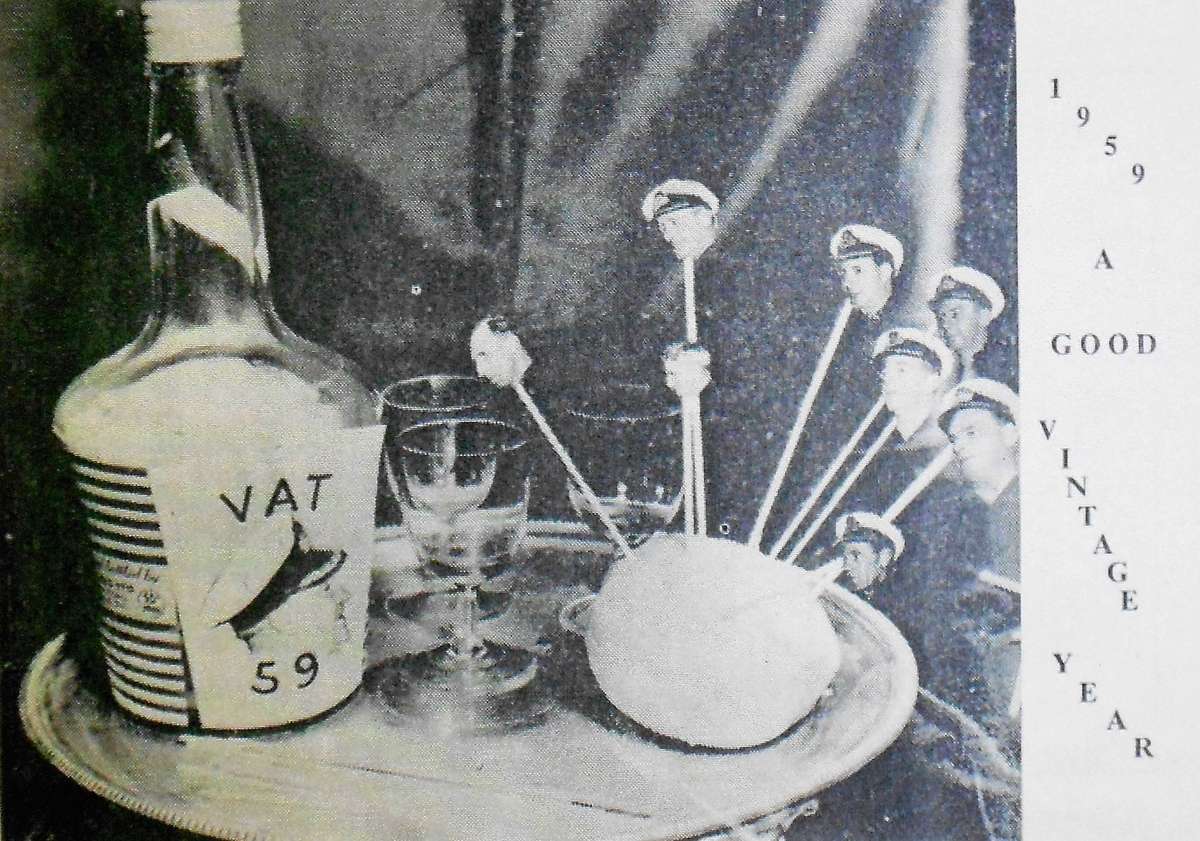 Smith said his almost three years in command at Albatross was satisfying with a great deal achieved in training and the introduction of new Sea Venom and Gannet aircraft. In 1959 Rear Admiral Harries did an inspection and reported that the Air Station was ‘a shining example of the Service at its best.’ An unusual duty was when the NSW Government sacked the Shoalhaven Council, which led to Smith being asked to act in the absence of a Council President at civic events and functions – helping Albatross and the Council to become closer than before. On leaving Albatross in November 1959 the Council gave Captain Smith and Nannette a civic farewell.
Smith said his almost three years in command at Albatross was satisfying with a great deal achieved in training and the introduction of new Sea Venom and Gannet aircraft. In 1959 Rear Admiral Harries did an inspection and reported that the Air Station was ‘a shining example of the Service at its best.’ An unusual duty was when the NSW Government sacked the Shoalhaven Council, which led to Smith being asked to act in the absence of a Council President at civic events and functions – helping Albatross and the Council to become closer than before. On leaving Albatross in November 1959 the Council gave Captain Smith and Nannette a civic farewell.
Left. Smith was the subject of endless “VAT 69 whiskey” jokes, such as this one that appeared in Slipstream magazine on his 1959 departure from RANAS Nowra.
In 1958 the RAN College moved from Cerberus FND to Jervis Bay. Smith was upset by the way the old college had deteriorated during the time it was a tourist resort and very glad to see Captain Dovers take over when the College was reinstated at Jervis Bay. At the end of 1959 Smith and his family sailed to Britain on SS Dominion Monarch, where he enrolled at the Imperial Defence College (later Royal College of Defence Studies) on 5 January 1960. His time at the IDC provided a rare opportunity for academic study and to participate in study tours, and to mix with senior officers from different services and countries.
HMAS Melbourne (11)
At the end of 1960, on completion of the IDC course, Smith was pleased to learn his next appointment would be at sea, from 8 January 1961, as Captain of the Flagship HMAS Melbourne and Chief Staff Officer to the Flag Officer Commanding the Australian Fleet. It was a welcome role as Smith had served on Sydney and several RN aircraft carriers. In 1961 and 1962 Melbourne sailed north to participate in international exercises and visit Southeast Asian ports. These cruises were successful although following one exercise Melbourne developed shaft trouble which was rectified at Hong Kong. A similar experience to that on Sydney as both ships did a lot of high speed steaming which they stood up to very well. Smith said sailing through the Inland Sea of Japan at night was a challenge due to the large number of fishing boats.
Another challenge was when tug boats and wharfies blackballed Melbourne during a visit to Auckland, refusing to assist on the ship’s departure. Smith’s answer was to line up the Gannets and Sea Venoms on the flight deck and with engines revving to ’pinwheel’ the ship away from the wharf – then to sail down the harbour with the band playing the ‘Maoris Farewell’. Obstacles were never a problem for Smith, when Melbourne’s catapult became unserviceable, rather than cancel an exercise, he ordered the Gannets to ‘range aft’ for free take-offs along the flight deck centreline. Nervous pilots consulted their handbooks, but soon found the Gannets airborne after passing the ship’s island, well before reaching the bow.
After 18 months Smith’s command of Melbourne finished on 16 June 1962. This ended his direct connection with the RAN Fleet Air Arm which contained only two breaks – in 1956 with the Frigates and in 1960 at the IDC – since writing the draft plan for the RAN Fleet Air Arm in 1945.
Below: CAPT Smith (centre) and officers enjoy a joke at the expense of RADM Harrington (left) aboard HMAS Melbourne, during a ship’s concert in 1961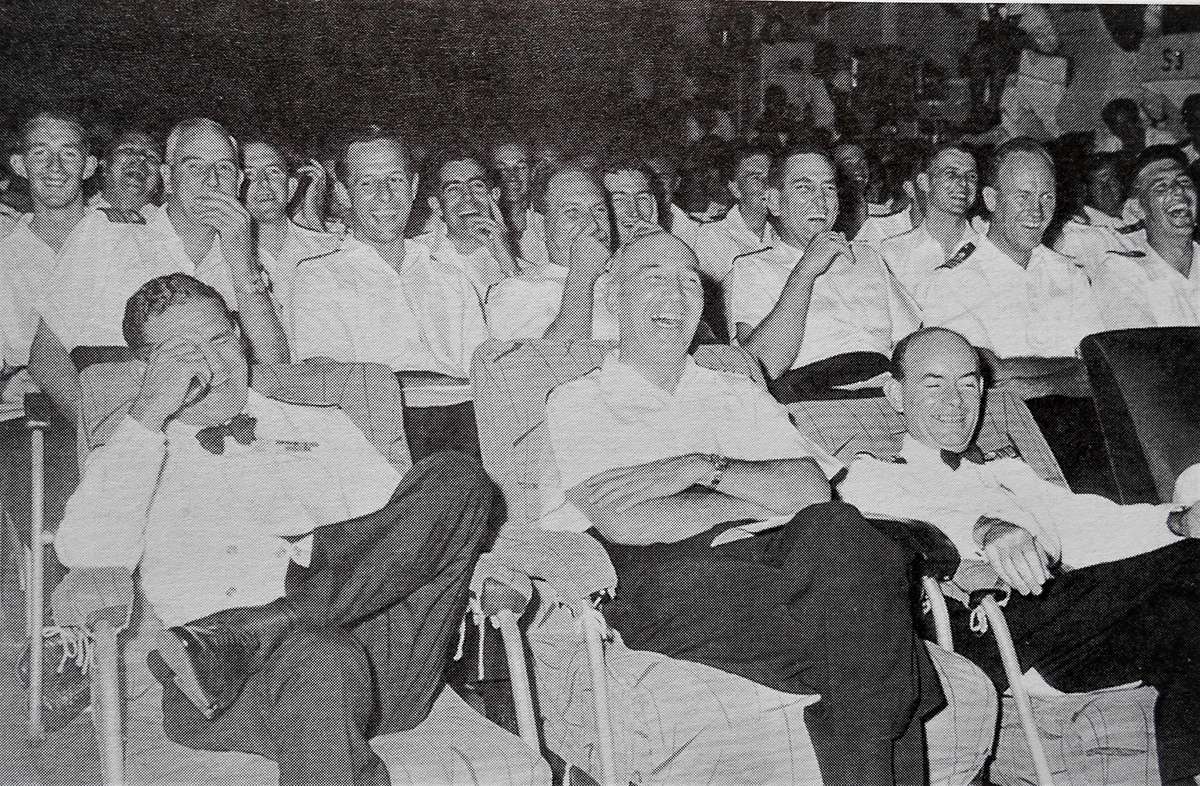
Command Duties & Honours
On 6 July 1962 Smith was appointed Second Naval Member of the Australian Naval Board and promoted to Acting Rear Admiral, confirmed in January 1963; and in the same year made Commander of the Order of the British Empire – with continuous service as Fourth Naval Member throughout 1965.
Left: The investiture at Government House, Canberra, of Admiral Sir Victor Smith’s KBE.
Right. Two photos from VADM Smith’s visit to Bearcat Base, Vietnam in 1969 when he was Chief of Naval Staff. Top: A welcome drink with LCDR Graham “Zork” Rohrsheim (L) and 1st Sergeant Johnston (C); Bottom: PO Ron Cole (L) discusses helicopter servicing with VADM Smith, with PO Kevin Camm at the rear with a US Army serviceman looking on.
On 10 January 1966 his next appointment was Flag Officer Commanding the Australian Fleet with HMAS Melbourne as his Flagship, assuming duty on 28 January 1966.
In January 1967 he joined Navy Office as Deputy Chief of Naval Staff and in June was made a Commander of the Order of the Bath. On 15 November 1967 he was promoted to Vice Admiral and made First Naval Member of the Commonwealth Naval Board.
In April 1968 he was appointed Chief of Naval Staff and made a Companion of the Order of the Bath, then in October 1969 a Knight Commander of the Order of the British Empire.
On 27 November 1970 he was appointed Chairman of the Chiefs of Staff Committee and promoted to Admiral – becoming the first graduate of the RAN College to reach that rank.
In 1975 he was made a Companion of the Order of Australia in the Military Division.
On 23 November 1975 Sir Victor retired after almost 49 years’ service.
Sir Victor Smith remained active in retirement supporting worthy causes and was the Patron of the Fleet Air Arm Association of Australia for many years. He died on 10 July 1998 aged 85. He is remembered by those who served with him, for his drive for excellence in naval aviation, and his concern for the welfare of all those under his command. He was a great Australian and a credit to the nation.
Lady Nanette Smith survived her husband by 19 years, finally passing away on 17 October 2017. She remained a staunch supporter of the Fleet Air Arm for the whole of her life and was sharp to the end. She was survived by her sons Mark and Piers, and their extended families.
A typhoon tale
Smith had gravitas and a commanding presence, yet he projected a disciplined calm, which included a sense of humour as the following suggests. In 1961 when he was captain of HMAS Melbourne the ship visited Hong Kong. During the stay Melbourne had to leave harbour at short notice due to an approaching typhoon. While most of the crew returned from leave before the ship sailed some did not make it. This included a sailor by the name of Johnson (a bit of a character) who during liberty hired a sampan to sail around the harbour. On each occasion Johnson went by Melbourne, he sounded a salute on his Bosun’s pipe. Remarkably – in the time honoured naval fashion Melbourne returned the salute – calling the ship’s company to attention. A week or so later during Divisions, Smith’s eye met that of ‘captain’ Johnson. He said: “Tell me captain – as one captain to another – how did you weather the typhoon?”
 Above: Admiral Sir Victor Albert Trumper Smith, AC, KBE, CB, DSC, RAN Retired.
Above: Admiral Sir Victor Albert Trumper Smith, AC, KBE, CB, DSC, RAN Retired.
09 May 1913 – 10 July 1998
References:
Australian War Museum
‘Carrier Operations in World War 2’ – by JD Brown
‘Flying Stations’ – ANAM
‘Navy News’ archive
‘Slipstream’ magazine archive
Trove: Australian National Library
‘A Few Memories of Sir Victor Smith’ – Australian Naval Institute
Wikipedia

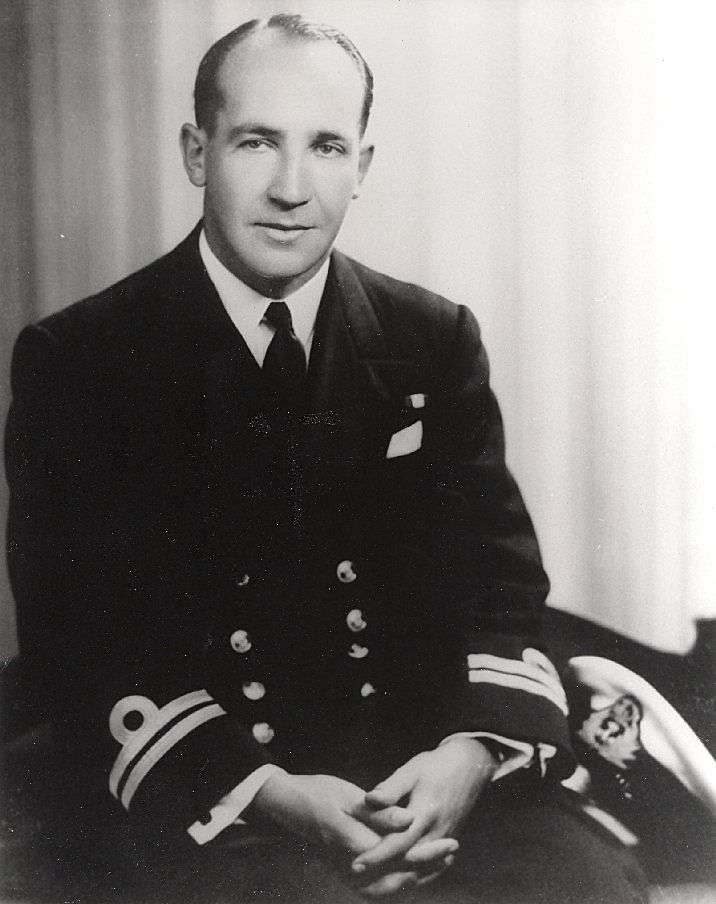

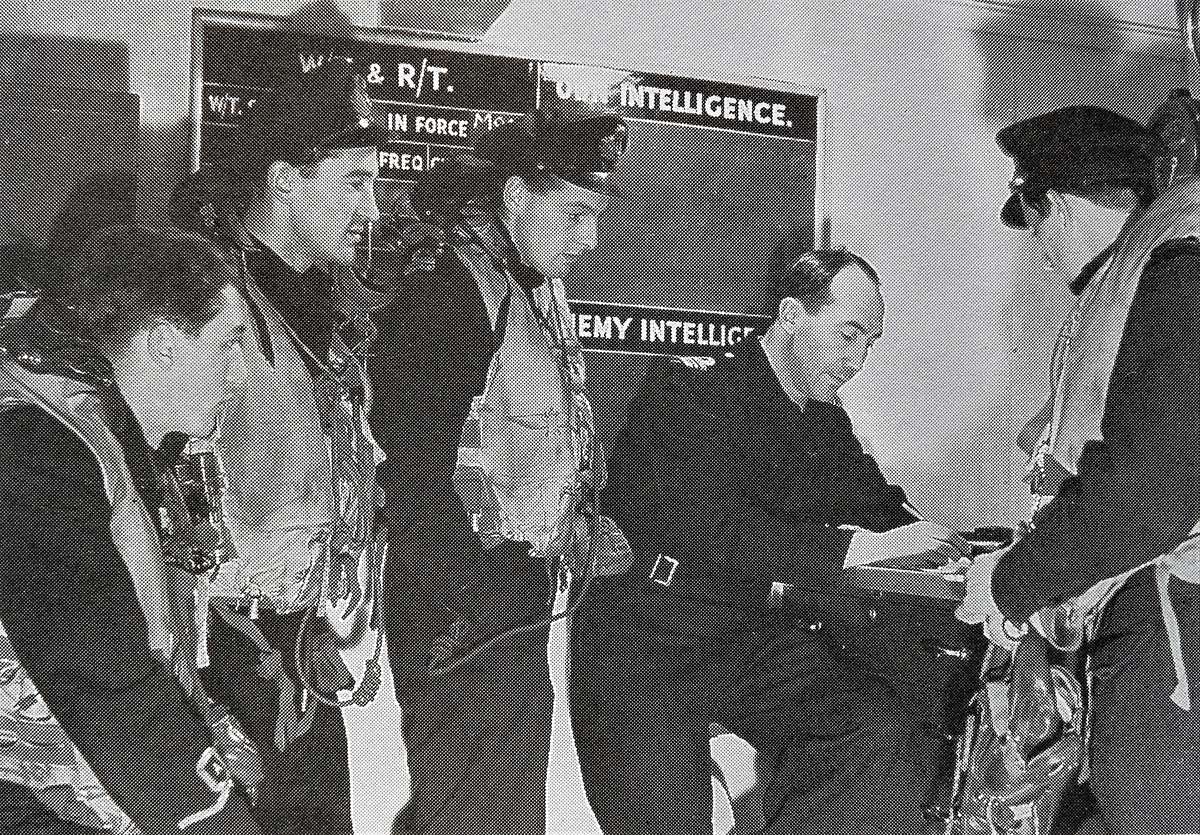 Left: A Swordfish overflies HMS Ark Royal. Above. Smith (seated) as Air Operations Officer aboard HMS Tracker operating in the Atlantic and Arctic.
Left: A Swordfish overflies HMS Ark Royal. Above. Smith (seated) as Air Operations Officer aboard HMS Tracker operating in the Atlantic and Arctic.